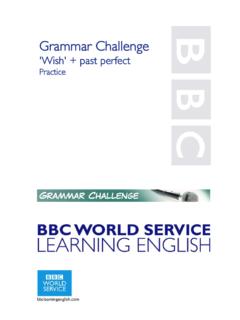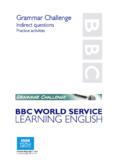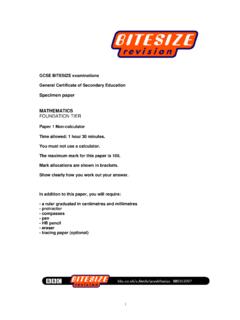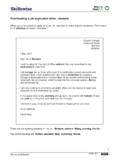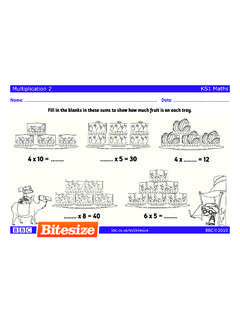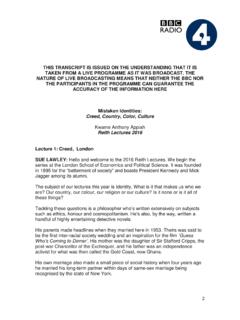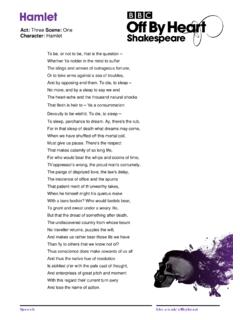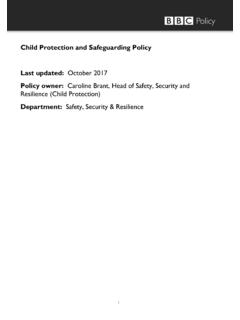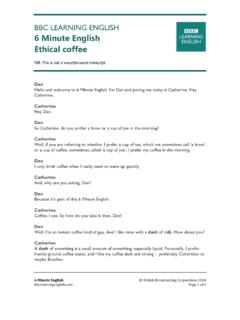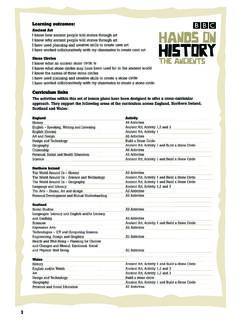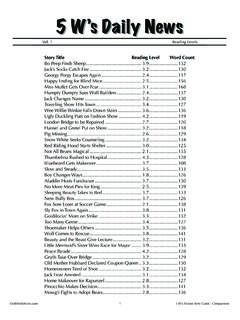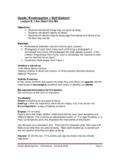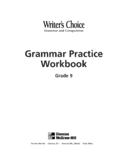Transcription of Tales of Hans Christian Andersen - BBC
1 School Radio BBC Radio1 School Radio BBC RadioAge 5-9 CDs: These programmes are available to order(for UK schools only) on pre-recorded CDs from:BBC Schools Broadcast RecordingsTel: 0370 977 2727 Monday to Friday 0800 to1800Or visit the Order CD page of the BBC SchoolRadio : These programmes areavailable as downloads or podcasts for 7 daysfollowing transmission. Further information atthe Podcasts page of the on demand: These programmes arealso available as audio on demand for 7 daysfollowing transmission. Refer to the transmission dates below to find out when programmes are available as podcasts and audio on :Readers: Anne-Marie Duff, Sir Derek Jacobi,David Tennant and Penelope WiltonProducer: Mark MaceyTeacher s Notes: Louise GlasspooleDesigned by: Nick Redeyoff Editor: Andrew BarnesContents:Introduction 2 Primary Literacy Framework links 5 Explanation of drama techniques 111: Thumbelina 14 Podcast / AOD begins 03/05/20112: The Little Mermaid 16 Podcast / AOD begins 10/05/20113: The Emperor s New Clothes 18 Podcast / AOD begins 17/05/20114: The Brave Tin Soldier 20 Podcast / AOD begins 24/05/20115: The Wild Swans 22 Podcast / AOD begins 07/06/20116: The Nightingale 24 Podcast / AOD begins 14/06/20117.
2 The Ugly Duckling 26 Podcast / AOD begins 21/06/20118: The Fir Tree 28 Podcast / AOD begins 28/06/2011 hans Christian AndersHnTales of hans Christian Andersen School Radio BBC Radio Tales of hans Christian Andersen2 School Radio BBC Radio hans Christian Andersen , 1805-1875 hans Christian Andersen was born in humble surroundings in Odense, Denmark, on 2 April, 1805, the son of a shoemaker and a washerwoman. His father loved literature and encouraged young hans to write Tales and put on puppet shows. However, he died when hans was just 11, which meant that the boy was sent out to work in order to support the family. He worked in a tailor s shop and tobacco factory, but was deeply unhappy, often being teased about his appearance (tall and thin with a long nose and close-set eyes) and his effeminacy.
3 At age 14 hans moved to the capital city Copenhagen in an attempt to pursue a career in the theatre. Initial success as a singer came to a halt when his voice broke, but associates complemented him on his poetry and he also began to write plays. One of the theatre directors arranged for some formal education to be paid for and hans attended Copenhagen University. hans was also able to travel widely around Europe, meeting various famous writers including Victor Hugo, Alexandre Dumas and Charles Dickens. Andersen continued to travel extensively throughout his adult life and often drew inspiration from his travels to aid his s best known works are his 'Fairy Tales and Stories', written between 1835 and 1872. His earliest stories were based on traditional folk Tales - much like the Tales of the Brothers Grimm, published twenty years earlier, had been.
4 However, the bulk of his Tales are original, with the most famous having passed into common parlance as metaphorical phrases (for example, 'The Ugly Duckling' and 'The Emperor s New Clothes'). A common theme of Andersen s work is the unfortunate or the outcast. This is likely to have arisen from the experiences of his own life the teasing he suffered as a child and the rejection he suffered in his personal life as an adult. Despite proposals made to several women, Andersen never married. He died of cancer on 4th August 1875, and was subsequently commemorated in his home city of Copenhagen through the statue of his character the Little Mermaid, which can be found by the harbour Radio BBC Radio Tales of hans Christian Andersen3 Fairy TalesOrigin, audience and purposeInformation from: oldest forms of fairy Tales were originally intended for adults and children.
5 These early folk Tales were passed down orally from generation to generation and later became increasingly associated with children as their audience. Their primary purposes are to amuse and to convey cultural information that influences behaviour (mountains can be dangerous places to travel alone, unselfish behaviour benefits the community and is rewarded, do as your parents tell you and all will be well).Later adaptations, written in a more literary and sophisticated style, are also among the traditional stories known as fairy Tales although the often gory and frightening content of the original stories was sometimes sanitised by those who composed new, written adaptations. Fairy Tales are found in most cultures and many derive from the oldest stories ever told.
6 New fairy Tales are still being written today although some of these texts with fairy-tale elements (such as 'The Hobbit') could be included in the more recently categorised genre of familiar themes of many traditional stories are prevalent in fairy Tales : magic and skill safe and dangerous good and evil weak and strong rich and poor wise and foolish old and young beautiful and ugly mean and generous just and unjust friend and foe family/home and stranger/far away the origins of the Earth, its people and animals the relationship between people and the seen or unseen world around Tales consistently include some of the most familiar and traditional archetypes of all folk Tales (hero, villain, mentor, trickster, sage, shape shifter, herald).
7 Human characters are simply the people who lived in the castles, cottages and hovels of the original stories: kings and queens, princes and princesses, knights and ladies, poor farmers, youngest sons, wise old women, beggars, tailors, soldier, a goose-girl. The main character is often humble, melancholy or hard-working and wants to make life also include a wide range of magical folk including animals or creatures who may have mystical powers yet behave with human characteristics. The names given to the inhabitants of the fairy world vary in different cultures but they include the little folk (elves, imps, fairies, leprechauns, pixies/piskies, goblins and dwarfs) as well as the larger and often more sinister trolls, giants, ogres, wizards and , the presence of fairies or talking animals is not necessarily the best way to identify a traditional tale as a fairy story.
8 Many fairy stories do not include fairies as characters and the main characters in fables are often talking and structureThe setting and details about when events took place are nearly always vague. (Once upon a A long, long time It happened Once there was a small cottage in the middle of a )School Radio BBC Radio Tales of hans Christian Andersen4 formulaic openings and endings; imagery: simile, metaphor and Tales are commonly presented as implausible but it is important to remember that in cultures where the inhabitants of the magical world are perceived as real, the stories may be interpreted more as legends, so that storyteller and reader/audience understand them to have some historical, factual stories tell the adventures of people in the land of fairy folk so plots usually include the use of magic, fantastic forces and fanciful creatures.
9 Sometimes the inhabitants of the magical land of faerie venture into the world of humans and this disruption of the status quo triggers a far-fetched sequence of events. Enchantments are common and rule-breaking has the hero or heroine is searching for something (a home, love, acceptance, wealth, wisdom) and in many Tales dreams are fulfilled with a little help from magic. Fairy tale endings (where everything turns out for the best) are common. Heroes overcome their adversaries and girls marry the prince of their dreams but many fairy Tales are darker and have a sad ending. The fairy Tales of hans Christian Andersen , for example, include many where things go from bad to worse even for good characters or where people s negative characteristics are their downfall at the end.
10 (The little match girl dies tragically in the snow, the fashion-obsessed emperor becomes a laughing stock when he parades through the city wearing nothing at all, the toy soldier melts away to a lump of lead.) This means that careful selection of texts is required to ensure Tales include good examples of the repetitive, rhythmic and patterned language of traditional stories. Phrases or expressions are repeated for emphasis or to create a magical, theatrical effect (so she went over the gate, across the meadow and down to the stream once not once, not twice, but three ).Fairy stories use: rich, evocative vocabulary the language of the fairy world (magic spells, incantations, charms) the spoken language of the ordinary people (dialogue, regional accent and dialect vocabulary, informal expressions) memorable language (rhyme, alliteration, assonance, repetition)School Radio BBC Radio Tales of hans Christian Andersen5 Assessment focuses for reading Levels 1-5, selected for relevance to the textsAF2 understand, describe, select or retrieve information, events or ideas from texts and use quotation and reference to textLevel 1In some reading, usually with support: some simple points from familiar texts recalledLevel 2In some reading.
